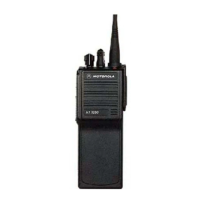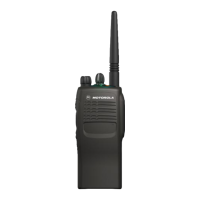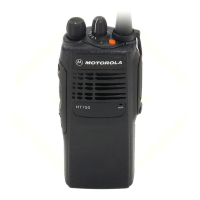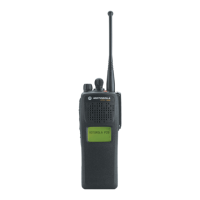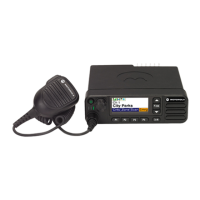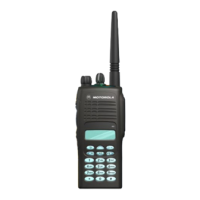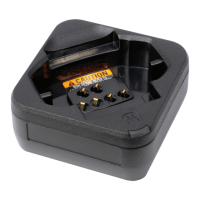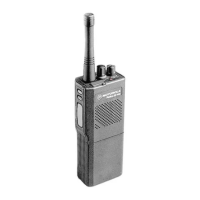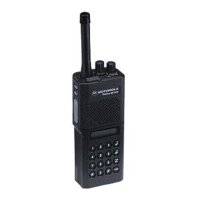3. With the meter selector switch (RTX4005B) set to
MIC, inject a 1 kHz tone on the AUDIO IN terminal
on the test set, 80mVrms as measured on the
AC/DC MTR port.
4. Press F6 to key the radio, and use the UP/DOWN
arrow keys to adjust the deviation per the values
shown in Table 40-16.
5. Press F6 to dekey the radio, and press F8 to pro-
gram the softpot value. Press ENTER to move to
the next softpot value.
6. Repeat steps 3-5 for the remaining frequencies
shown on the screen.
7. Press F10 to return to the TRANSMIT menu.
I. Transmit Deviation Limit Reference
NOTE
1. This procedure is not required for 900 MHz
models.
2. This procedure is required for VHF, UHF, and
800 MHz models with 20 kHz channel spacing
and VHF and UHF models with 12.5 kHz chan-
nel spacing.
1. Press F6 to select the TRANSMIT DEVIATION
LIMIT REFERENCE softpot.
2. With the meter selector switch (RTX4005B) set to
MIC, inject a 1 kHz tone on the AUDIO IN terminal
on the test set, 80mVrms as measured on the
AC/DC MTR port.
3. Press F6 to key the radio, and use the UP/DOWN
arrow keys to adjust the deviation per Table 40-17.
4. Press F6 to dekey the radio, and press F8 to pro-
gram the softpot value.
5. Press F10 to return to the TRANSMIT menu.
J. VCO Crossover Frequency
NOTE
This procedure is only required after the field repair
of a VHF or UHF VCO.
In order for a phase-locked-loop to tune very wide
bandwidths, both negative and positive control voltages
(Vcntl) are required. This procedure sets the crossover
frequency at which the negative Vcntl (or –Vee) switch-
es from zero to negative.
TX VCO Crossover
1. From the SERVICE menu, press F2 to select
TRANSMITTER alignment.
2. Press F7 to select the TRANSMIT VCO
CROSSOVER softpot. The screen will indicate the
transmit test frequency to be used.
3. Connect a dc voltmeter capable of 1mV resolution
to test point 5 (TP5), which is accessible through a
hole in the bottom side VCO circuitry shield.
4. Beginning with the default softpot frequency of line
2, press F6 to key the transmitter, and adjust the
UP/DOWN arrow keys until the voltage reading at
TP5 is 3.0 ±0.1 volts. The frequency will increment
in steps of 50kHz.
5. Press F6 again to dekey the transmitter, and press
F8 to program the softpot value.
6. Press F10 twice to return to the SERVICE menu.
RX VCO Crossover
1. From the SERVICE menu, press F3 to select
RECEIVER alignment.
2. Press F5 to select the RECEIVE VCO
CROSSOVER softpot. The screen will indicate the
receive test frequency to be used.
3. Connect a dc voltmeter capable of 1mVolt resolu-
tion to test point 5 (TP5), which is accessible
through a hole in the bottom side VCO circuitry
shield.
4. Beginning with the default softpot frequency of line
2, adjust the UP/DOWN arrow keys until the voltage
reading at TP5 is 3.0 ±0.1 volts.
5. Press F8 to program the softpot value.
6. Press F10 twice to return to the SERVICE menu.
K. Signalling Deviation
Transmit deviation balance compensation and
transmit deviation limit adjustments should be complet-
ed before signalling deviation is adjusted.
DTMF Tuning
1. From the SERVICE menu, press F4 to select SIG-
NALLING alignment.
2. Press F4 again to select the DTMF softpot.
3. Press F6 to key the radio on the test frequency.
The screen will indicate that the radio is
transmitting.
4. Measure the DTMF deviation on your service
monitor.
5. Use the UP/DOWN arrow keys to adjust the DTMF
deviation per table 40-16.
6. Press F6 again to dekey the radio.
7. Press F8 to program the softpot value; press F10
to return to the SIGNALLING menu.
15
Table 40-16. Transmit Deviation Limit
BAND DEVIATION (KHZ)
VHF/UHF/800 MHz 4.30 - 4.60
900 MHz 2.20 - 2.30
Table 40-17. Transmit Deviation Limit Reference
CHANNEL SPACING DEVIATION (KHZ)
20 KHz 3.40 - 3.60
12.5 KHz 2.20 - 2.30
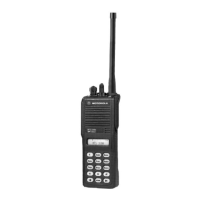
